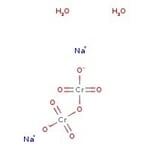Search Thermo Fisher Scientific
Dichromate de sodium dihydraté, qualité réactif, Thermo Scientific Chemicals



Dichromate de sodium dihydraté, qualité réactif, Thermo Scientific Chemicals
Identifiants chimiques
Spécifications
Description
This Thermo Scientific Chemicals brand product was originally part of the Alfa Aesar product portfolio. Some documentation and label information may refer to the legacy brand. The original Alfa Aesar product / item code or SKU reference has not changed as a part of the brand transition to Thermo Scientific Chemicals.
Figures
Documentation et téléchargements
Certificats
Foire aux questions (FAQ)
Citations et références
Sécurité et manipulation
Classification of the substance or mixture
CLP classification - Regulation(EC) No 1272/2008
Label Elements
Signal Word
Danger
Hazard Statements
H301 - Toxic if swallowed
H312 - Harmful in contact with skin
H314 - Causes severe skin burns and eye damage
H317 - May cause an allergic skin reaction
H330 - Fatal if inhaled
H334 - May cause allergy or asthma symptoms or breathing difficulties if inhaled
H340 - May cause genetic defects
H350 - May cause cancer
H360FD - May damage fertility. May damage the unborn child
H372 - Causes damage to organs through prolonged or repeated exposure
H410 - Very toxic to aquatic life with long lasting effects
Physical hazards
H272 - May intensify fire; oxidizer
Precautionary Statements
P210 - Keep away from heat, hot surfaces, sparks, open flames and other ignition sources. No smoking
P220 - Keep away from clothing and other combustible materials
P280 - Wear protective gloves/protective clothing/eye protection/face protection
P284 - Wear respiratory protection
P301 + P330 + P331 - IF SWALLOWED: Rinse mouth. Do NOT induce vomiting
P303 + P361 + P353 - IF ON SKIN (or hair): Take off immediately all contaminated clothing. Rinse skin with water or shower
P305 + P351 + P338 - IF IN EYES: Rinse cautiously with water for several minutes. Remove contact lenses, if present and easy to do. Continue rinsing
P310 - Immediately call a POISON CENTER or doctor/physician